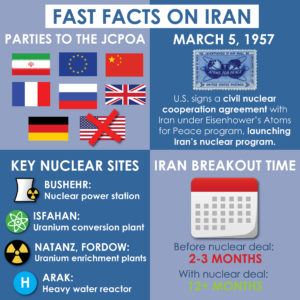 Beginning formally in 2013, nations of the P5+1 (the United States, France, the United Kingdom, China, Russia, plus Germany) and the European Union engaged in diplomatic negotiations with Iran to address the international community’s concerns over Iran’s nuclear program.
Beginning formally in 2013, nations of the P5+1 (the United States, France, the United Kingdom, China, Russia, plus Germany) and the European Union engaged in diplomatic negotiations with Iran to address the international community’s concerns over Iran’s nuclear program.
On July 14, 2015, after two years of negotiations, the P5+1 and the European Union announced the Joint Comprehensive Plan of Action (JCPOA) to prevent Iran from obtaining a nuclear weapon. Under the agreement, known as the Iran nuclear deal, Iran significantly reduced its nuclear program and accepted strict monitoring and verification safeguards to ensure its program is solely for peaceful purposes. In exchange, Iran received economic sanctions relief from nuclear-related sanctions (all other sanctions remained in place), but only after the International Atomic Energy Association (IAEA) verified that Iran had completed its initial requirements under the agreement.
In May 2018, former President Donald Trump pulled the United States out of the JCPOA without cause and re-imposed nuclear-related sanctions on Iran. Up until May 2019, a full year after the United States withdrew from the deal, the IAEA routinely verified that Iran was in full compliance under the JCPOA. After that, Iran began incrementally stepping back from compliance with the deal while the other parties to the agreement have remained committed to its implementation. Since the United States abrogated the deal and Iran in turn stopped honoring some of its commitments, Iran has reduced its breakout time — the amount of time it would take to accumulate enough fissile material for a nuclear weapon — from more than a year to about 3-4 months, although the IAEA remains on the ground to verify the peaceful nature of its nuclear program.
The Center for Arms Control and Non-Proliferation works within a broad coalition of organizations to support this diplomatic non-proliferation effort. Our experts recommend that the United States returns to compliance with the JCPOA as it is the only responsible pathway to verifiably constrain Iran’s nuclear program.
Recent Analysis on Iran
- Exploring Iran’s Nuclear Program February 20, 2025
- Lessons from South Africa: A New Strategy for Iran’s Nuclear Threat January 7, 2025
- IAEA chief tours sensitive Iran nuclear plants November 15, 2024
- Israel’s Iron Dome Threatened by Precision-Guided Munitions October 9, 2023
- Melding U.S. Non-Proliferation Strategy with Middle East De-Escalation Dynamics June 23, 2023
- Will the secretive US-Iran talks deliver breakthrough or crumble in disappointment? June 20, 2023
- Op-ed: Can an interim deal break the Iran nuclear impasse? February 7, 2023
- Iran’s Foreign Minister admits to sending drones to Russia, admission comes after repeated denials November 6, 2022
- What’s At Stake for U.S. and Iran in Last Chance for the Nuclear Deal August 18, 2022
- The latest on Iran deal negotiations August 11, 2022
